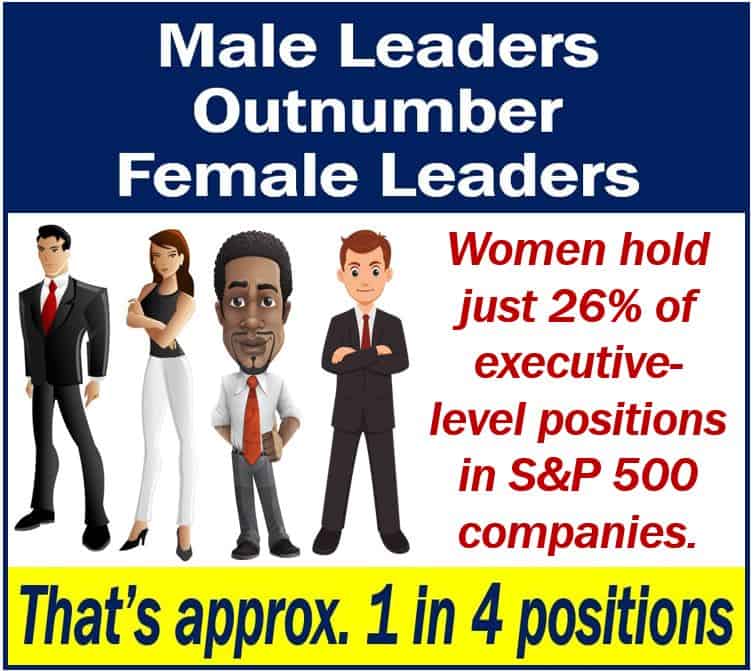Male leaders still massively outnumber female leaders, a new study found. Women hold only twenty-six percent of executive-level positions in S&P 500 Companies. S&P 500 companies are the 500 largest companies with common stock listed on NASDAQ and NYSE.
In other words, out of every four executive-level positions, approximately three are men and one is a woman.
This abundance of male leaders is not an accident, says a team of researchers. The researchers are from the University at Buffalo School of Management, the University of Illinois at Urbana‐Champaign, the University of Maryland, and Northwestern University.
They wrote about their study and findings in the journal Personnel Psychology (citation below).
Male leaders vastly outnumber female counterparts
According to study leaders Katie Badura and Emily Grijalva, male leaders are much more likely to emerge than female leaders. Badura is a doctoral student and Grijalva PhD. is an assistant professor of organization and human resources. They both work at the University at Buffalo School of Management.
The researchers aggregated fifty-nine years of research. They gathered and analyzed data on over 19,000 participants from 136 studies. The studies occurred in classroom and business settings. They also took place in laboratory settings.

Gender gap is still present
Even though the gender gap has narrowed over recent decades, they found that it persists.
Badura said:
“As a society, we’ve made progress toward gender equality, but clearly we’re not quite there.”
“Our results are consistent with the struggle many organizations face today to increase diversity in their leadership teams.”
Gender gap – societal pressures
The research team attributes the gender gap primarily to societal pressures. These pressures contribute to differences in personality characteristics.
Men, for example, tend to be more dominant and assertive. Women, on the other hand, are more nurturing, cooperative, and communal.
Subsequently, in group discussions, for example, men are more likely to voice their opinions and participate.
Others then perceive the men more as male leaders than the women as female leaders.
Male leaders maybe there for the wrong reasons?
Prof. Grijalva explains:
“We found showing sensitivity and concern for others – stereotypically feminine traits – made someone less likely to be seen as a leader.”
“However, it’s those same characteristics that make leaders effective. Thus, because of this unconscious bias against communal traits, organizations may unintentionally select the wrong people for leadership roles, choosing individuals who are loud and confident but lack the ability to support their followers’ development and success.”
Gender gap strong at first, then weakens
Participants’ ages and group size did not affect the gender gap, the authors found. However, how long the participants spent together was a major factor in determining the ratio of female to male leaders.
The longer the members of a group spent together, the less gender determined who emerged as the group’s leader.
Prof. Grijalva said:
“The gender gap was strongest during the first 20 minutes people were together, similar to an initial job interview, but weakened after more than one interaction.”
“During the hiring process, organizations should conduct multiple interviews to reduce gender bias and ensure they’re hiring the best applicant.”
For managers, the authors suggest prompting quieter people to share their ideas and promoting the value of communal behaviors in performance evaluations. They added that organizations should be mindful of any unconscious biases that employees may have.
Badura said:
“In the Obama White House, female staffers adopted a strategy of amplifying one another’s comments during meetings and giving credit to the individual who said it first, to ensure that women’s voices were being heard.”
“Tactics like this help the most qualified individuals stand out and emerge into leadership roles – regardless of gender.”
Researchers from the University of Zurich recently identified which qualities set leaders apart. They found that leaders are more willing to take responsibility for making decisions. Specifically, decisions that affect the welfare of others.
Citation
“Gender and leadership emergence: A meta‐analysis and explanatory model,” Katie L. Badura, Emily Grijalva, Daniel A. Newman, Thomas Taiyi Yan, and Gahyun Jeon. Personnel Psychology. First Published 12 March 2018. https://doi.org/10.1111/peps.12266.
_________________________________
Interesting related articles:
- “Gender-specific work preferences when gender equality and economic development is greater.”
- “What is inequality?“
- “Are women less corrupt than men?“
_________________________________
Video – Male leaders outnumber female leaders
In this University at Buffalo School of Management video, Katie Badura and Emily Grijalva talk about why men are more likely than women to emerge as leaders.
